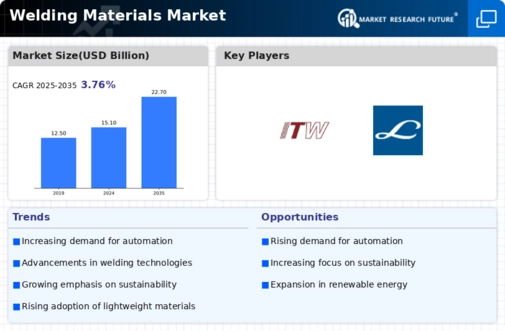Top Industry Leaders in the Welding Materials Market

The global welding materials market is a dynamic and intensely competitive landscape. Numerous players vie for market share, employing diverse strategies and adapting to evolving industry trends. This report delves into the key factors shaping the competitive landscape, analyzes recent developments, and provides a comprehensive overview of the market.
Strategies Adopted by Market Players:
- Product Diversification: Leading companies are expanding their portfolios beyond core offerings, venturing into advanced materials like high-strength steels, aluminum alloys, and specialty consumables for niche applications. This caters to diverse industry needs and fosters customer loyalty.
- Technological Prowess: Research and development (R&D) play a crucial role in gaining an edge. Companies are investing heavily in automation, robotics, and advanced welding processes like laser and friction stir welding. This focus on efficiency, precision, and productivity attracts new customers and strengthens brand image.
- Strategic Partnerships and Acquisitions: Collaborations with research institutions, equipment manufacturers, and distributors expand market reach and access to new technologies. Acquisitions of smaller players or niche specialists add valuable expertise and market share.
- Focus on Sustainability: Environmental consciousness is driving demand for eco-friendly welding materials with low emissions and reduced environmental impact. Companies are developing green consumables, implementing resource-efficient manufacturing processes, and promoting sustainability initiatives to attract environmentally conscious customers.
- Geographic Expansion: Emerging economies with burgeoning infrastructure and industrial development offer significant growth potential. Established players are setting up manufacturing facilities or entering into strategic partnerships in these regions to capitalize on the demand.
Factors Influencing Market Share:
- Brand Reputation and Quality: Established brands with a proven track record of quality and reliability command higher market share. Consistent product performance and adherence to industry standards are crucial for customer trust and retention.
- Price Competitiveness: Cost plays a significant role, especially in price-sensitive segments. Players offering competitive pricing strategies and cost-effective solutions gain an edge in saturated markets.
- Distribution Channels and Customer Service: Efficient distribution networks and responsive customer service ensure timely delivery, technical support, and prompt resolution of customer queries. This builds customer satisfaction and loyalty, boosting market share.
- Compliance with Regulations: Stringent safety and environmental regulations necessitate stringent quality control and adherence to compliance standards. Companies with a robust compliance framework gain trust and market share.
List of Key Players in the Welding Materials Market:
- Ador Welding Ltd.
- Air Liquide
- Air Products and Chemicals Inc.
- Colfax Corporation
- Illinois Tool Works Inc.
- The Linde Group
- Praxair Technology Inc.
- The Lincoln Electric Company
- Gedik Welding
Recent Developments:
August 2023: ESAB acquires Interweld, a leading European distributor of welding consumables, strengthening its market position in Europe.
September 2023: The Linde Group unveils its new Eco Arc welding technology, offering significant reductions in emissions and energy consumption.
October 2023: Fronius International launches a new line of automated welding robots designed for high-precision and high-speed welding applications.
November 2023: The American Welding Society (AWS) releases a new industry standard for the use of recycled materials in welding consumables.
December 2023: The global welding materials market experiences a slight dip due to the holiday season and economic uncertainties.
January 2024: The market shows signs of recovery as major infrastructure projects resume and demand from the automotive sector picks up.

